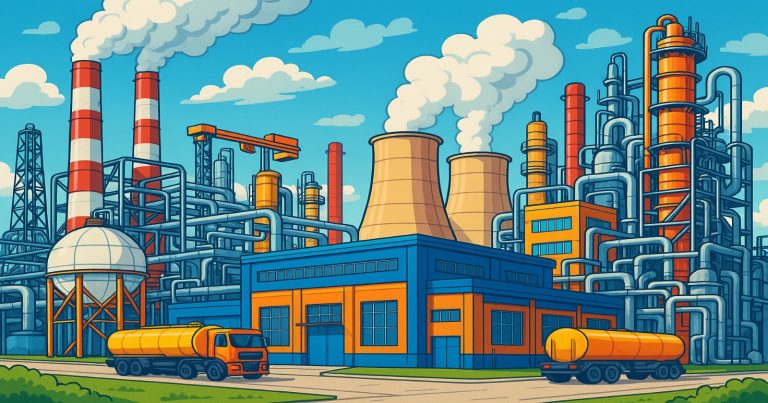Large-scale industries have become the backbone of modern economies. They support growth, employment, and technological advancements. These industries comprise massive production units that rely heavily on capital investment, technological sophistication, and a vast number of employees. In this regard, from the manufacture of steel to the production of chemicals and automobiles, large-scale industries support the very fabric of the country’s economic infrastructure and, thereby, form the key pillar in the global landscape of trade and industrialization.
What are Large Scale Industries?
Large-scale industries are industrial operations characterized by large-scale investments, modern machinery, and large employment generation. They produce huge quantities of goods, either for the local market or foreign markets. These industries are generally located in industrial estates and require specific infrastructure, including factories, ports, and transportation networks. These industries drive economic development by creating employment opportunities, boosting exports, and driving technological progress. These industries also increase national self-reliance by lessening the reliance on imported goods such as steel, cement, and machinery.
Characteristics of Large Scale Industries
Large scale industries are defined by several key features that set them apart from small-scale or cottage industries:
- Mass Production: High volume of production to meet the market demand and minimize the cost per unit.
- High Capital Requirements: The industries require high amounts of capital for land, equipment, raw materials, and operations.
- Advanced Technology: Automation, heavy machinery, and sophisticated production techniques are required to ensure efficiency and scalability.
- Specialized Workforce: Large-scale industries employ workers skilled in different trades, from engineers to technicians and manual laborers.
- National Importance: They greatly impact a nation’s GDP foreign exchange earnings and industrial capabilities.
Large Scale Industries in India
Various large scale industries dominate the industrial landscape of India and have been crucial in the country’s economic rise. These industries, over the years, have not only contributed to GDP growth but also significantly contributed to exports and job creation.
Historical Evolution
The journey of large-scale industries in India dates back to the British period. Starting with textile mills and jute factories, India entered the post-independence phase by giving industrialization priority in the Five-Year Plans. It witnessed the emergence of many PSUs, such as SAIL and HAL. The liberalization policies of the 1990s opened the doors further for private investments, which enhanced the automotive, IT, and pharmaceutical sectors.
Prominent Large Scale Industries in India
- Steel Industry: India is one of the world’s largest steel-producing countries. Companies such as Tata Steel, JSW Steel, and SAIL are leaders in the industry. Steel production is used for infrastructure development, such as roads, bridges, and railways.
- Automobile Industry: India is a global leader in automobile manufacturing, producing cars, two-wheelers, and heavy vehicles. Companies such as Maruti Suzuki, Tata Motors, and Mahindra cater to the domestic and international markets.
- Textile Industry: One of the oldest industries in India, the textile sector is a significant exporter of cotton, silk, and ready-made garments. It generates employment for millions, particularly in rural areas.
- Cement Industry: With companies like UltraTech Cement and Ambuja Cement, India is among the largest cement producers globally. Cement is vital for infrastructure and housing development.
- Pharmaceutical Industry: India is known as the “pharmacy of the world,” which exports generic medicines and vaccines. Among these companies, Sun Pharma and Dr. Reddy’s Laboratories are notable leaders.
Advantages of Large Scale Industries
Large scale industries offer numerous benefits that drive economic growth and improve the standard of living for citizens. Advantages of large scale industries are as follows:
Economic Benefits
- Economies of Scale: By producing in bulk, large scale industries significantly reduce the cost per unit, and goods are made affordable. Lower costs improve competitiveness in international markets.
- Infrastructure Development: Large-scale industries usually drive the development of roads, ports, and power plants. This will benefit the whole economy by making connectivity and efficiency better.
- Foreign Exchange Earnings: Textiles and automobiles, which are exported through large scale industries, generate a considerable amount of foreign exchange reserve.
- Technology Transfer: Collaboration with global players helps introduce advanced technology and modern practices to the domestic market.
Social Advantages
- Employment Generation: These industries give employment to millions of people, ranging from unskilled laborers to very skilled engineers. Employment enhances income levels and living standards.
- Community Development: Many large-scale industries engage in corporate social responsibility (CSR). They invest in schools, health facilities, and housing for the workers and the neighboring communities.
- Living Standards Improvement: Mass production makes such products as cars, cement, and electronics cheap, thereby raising the standard of living.
Disadvantages of Large Scale Industries
While large scale industries contribute significantly to economic growth, they also pose challenges that require careful management. Following are the disadvantages of large scale industries:
Economic Drawbacks
- High Initial Investment: Setting up and operating these industries is very costly and limits their participation to only large corporations or governments.
- Market Monopolies: Large industries create market monopolies that limit competition for small-scale industries.
Environmental Concerns
- Pollution: Industrial activities cause air, water, and soil pollution, which has bad effects on health and the environment. Some examples are the gases emitted by steel plants and chemical effluents.
- Resource Depletion: Industry consumes a lot of coal and minerals, which are non-renewable resources and scarce.
Social Issues
- Urbanization Pressure: Industrial hubs attract migration, leading to overcrowding, slums, and infrastructure strain.
- Labor Exploitation: In some cases, industries exploit workers through low wages and unsafe working conditions.
Large Scale Industries Examples
The global and Indian markets provide numerous examples of large-scale industries that have shaped economies.
Global Examples
- ArcelorMittal: A global leader in steel production with operations in over 60 countries.
- Toyota Motors: Renowned for its innovative automobile manufacturing techniques.
Indian Examples
- Reliance Industries: A leader in petrochemicals, refining, and telecommunications.
- Tata Steel: Among the oldest and most respected steel manufacturers in India.
Large Scale Industries FAQs
What are large scale industries?
Large scale industries are large operations involving mass production, significant capital investment, and a large workforce, contributing to economic growth and export revenue.
Why are large scale industries important?
They drive GDP growth, create employment, and enhance infrastructure, playing a vital role in national development.
What are some examples of large scale industries in India?
Examples include Tata Steel, Reliance Industries, Maruti Suzuki, and Sun Pharma.
How do large scale industries impact the environment?
They contribute to pollution and resource depletion, necessitating sustainable practices to mitigate damage
What are the disadvantages of large scale industries?
Challenges include high setup costs, potential monopolies, labor exploitation, and environmental degradation.


